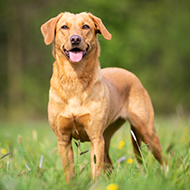Genetic test identifies dogs' risk of cruciate ligament damage

The findings enabled researchers to ascertain the genetic risk of developing cruciate ligament rupture in Labrador retrievers.
US researchers have developed a first-of-its-kind genetic test that identifies a dog's risk for cruciate ligament damage.
The test, developed by scientists at the University of Wisconsin-Madison School of Veterinary Medicine, requires only a blood sample or a cheek swab that can be collected at home.
Researchers first developed the test for Labrador retrievers – a breed with a high risk of developing the disease – in September 2021. The team now hopes to extend the tool to other susceptible breeds, such as the Newfoundland and the Rottweiler.
Similar to the anterior cruciate ligament (ACL) in humans, the canine cranial cruciate ligament plays a crucial role in stabilising the knee joint in both species. While any dog can rupture the ligament, it seldom occurs through injury alone.
Instead, the deterioration of the cruciate ligament, which increases the chance of rupture, is greatly influenced by genetics, scientists say.
Identifying if a dog is more likely to rupture a cruciate ligament due to genetics enables its owner and veterinary surgeon to take preventative action, such as keeping the dog healthy and monitoring for signs of injury. It can also help to avoid the recovery and expenses involved in a rupture.
The new test was developed by Professor Peter Muir who, together with his team, analysed the genome of more than 1,000 Labrador retrievers across the USA. According to Muir, genetic markers for cruciate ligament ruptures are more complex than markers for other traits.
Most genetic tests seek one particular DNA mutation to determine whether a particular disease or trait is present. However, several gene variants found across the dog's genome contribute to cruciate ligament rupture.
“There are all these little variants that act together,” explained Muir, “so, any individual Labrador that inherits enough small effect variants in combination will have high genetic risk typical of a cruciate ligament rupture case.”
The team used array genotyping to determine genetic markers for each dog. By studying the DNA and gene variants in multiple samples, they could pinpoint the minor variants associated with cruciate ligament rupture.
Their findings enabled them to ascertain the genetic risk of developing cruciate ligament rupture in Labrador retrievers. They found a heritability estimate of 0.62, meaning for each Labrador that develops cruciate ligament rupture, about 62 per cent of the risk is genetic, and approximately 38 per cent is environmental.
From this study, a cruciate ligament rupture genetic risk test for individual Labrador retrievers can now be performed in the lab with 98 per cent accuracy. Looking ahead, the team hopes to further genetic testing research for animals and humans alike.
“Our initial interest in the disease is as a spontaneous animal model for human orthopaedic disease,” Muir explains, to better understand human ACL tears and associated genetics.



 The BSAVA has opened submissions for the BSAVA Clinical Research Abstracts 2026.
The BSAVA has opened submissions for the BSAVA Clinical Research Abstracts 2026.